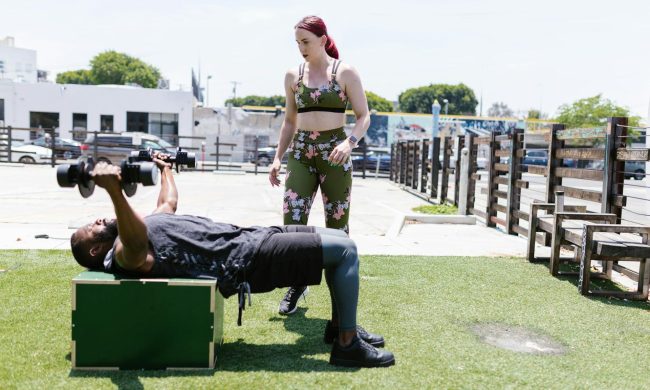Bodybuilding is a competitive and recreational sport where the winner is chosen based on impressive muscle size and definition. The three main phases of bodybuilding are bulking, cutting, and maintenance. Bodybuilders are looking to maximize muscle size when preparing for a competition or event, and many have developed their own way of bulking with different nutritional methods and exercise programs. So, should bulking involve cardio? Would cardio help trim fat and improve muscle strength and definition, or would it hamper results? Recent research reveals a sweet spot of just the right amount of aerobic exercise for the optimal outcome. Let’s dive into this topic and the recent research.
What is bulking?

Bulking describes the process of building or adding muscle tissue. Bodybuilders use the term when they go into a calorie surplus and consume more calories than they’re expending in energy in order to build or ‘bulk up’ their muscles. The calorie surplus goes along with resistance training, where you use external resistance, such as dumbbells or a barbell, to activate and work your muscles and stimulate muscle growth. The extra calories provide the fuel to boost muscle size and help you to power through the weight training.
Some people believe bulking is beneficial, while others believe it isn’t the best way to build muscle mass. Bulking is a phase of bodybuilding that many bodybuilders use to help them sculpt and grow their muscles, ready for an upcoming competition or show. The bulking phase varies but typically lasts about 4-6 months.
What is clean bulking vs. dirty bulking?

Bulking usually involves consuming 10-20% over your daily calorie needs. Clean bulking involves selecting healthier and better-quality foods, whereas dirty bulking means eating as much as you can without concern about food quality or hitting a specific surplus.
Should you do cardio while bulking?

Many lifters echo concerns that too much cardio, like swimming, running, or cycling, can kill gains and hinder muscle growth. A study from decades ago showed that 10 weeks of cardio alongside resistance training interfered with muscle growth compared to resistance training alone. However, many academics and fitness professionals point out issues with this study and state that it isn’t sufficient evidence alone to draw clear conclusions. The study also involved six days a week of cardio plus five days a week of strength training, and most bodybuilders that incorporate cardio into the bulking phase wouldn’t be doing 30-40 minutes of cardio six days a week on top of weightlifting.
Trim the fat
Excess calorie intake can cause body fat to accumulate during bulking, and incorporating cardio can help trim the fat. Recent research concludes that a moderate amount of cardio can enhance the effects of strength training, which indicates that the amount of cardio matters.
Should you do cardio if you’re trying to gain muscle?

Cardio doesn’t help you build muscle in the same way that weight training does; however, it doesn’t necessarily contribute to muscle loss either. A well-rounded workout routine that includes the right amount of cardio and strength training can set you on the road to serious gains. You can build muscle and still be able to climb flights of stairs without feeling too exhausted, as the cardio improves your heart health, general fitness, and stamina.
How much cardio should you do while bulking?

Studies reveal resistance training, along with 2-3 days of cardio every week, can lead to more significant gains compared to strength training alone. There’s a sweet spot of just the right amount of cardio to complement your training gains. Too much cardio can interfere with muscle growth, but the right amount provides plenty of benefits. Some fitness professionals and bodybuilders recommend shooting for two or three 20-30-minute aerobic exercise sessions every week while bulking. Ideally, place your cardio sessions after lifting or on your rest days in between.
The main reasons to try cardio while bulking

Here are the main reasons to try cardio while bulking:
- Protect your heart health while you’re performing intense weight training and putting strain on your muscles, tissues, organs, and bones.
- Boost stamina and endurance.
- Increase your blood circulation.
- Improve muscle definition and body composition.
- Enhance your general health and overall fitness level.
- Burn more fat at rest and help keep your body lean.
- Boost your strength training results with the right amount of cardio every week.
- Increase your oxygen uptake.
- Lower your blood pressure.
- Improve your sleep quality.
- Enhance your mood and release feel-good endorphins.
The best types of cardio to try while bulking

Most bodybuilders incorporate some type of cardio while bulking, but they tend to stay away from high-intensity aerobic workouts that would take away much-needed fuel from their weight training sessions.
Workouts that are lower-impact and emphasize concentric muscle action rather than eccentric muscle contractions work best. For example, one interesting study highlights that strength training along with cycling enhances muscle size more than strength training along with treadmill walking or just strength training alone.
Some bodybuilders use the elliptical machine or try incline walking on the treadmill at a brisk pace multiple days a week. Others use the Stairmaster in the gym or go jogging or power walking in the great outdoors. Some prefer to incorporate high-intensity interval training, such as ten-minute workouts where you quickly move from push-ups to planks and then jumping jacks followed by burpees. Keep in mind that higher-intensity aerobic workouts burn through more calories, so you’ll need to consider your calorie surplus to stay in the bulking phase. You’ll also be more tired and might need a little more time to recover from these workouts.
The bottom line

Try to make sure you give your muscles sufficient time to rest and recover between your cardio and strength training sessions. You might need to experiment with your training schedule to find out what works best for you. It’s a balancing act because you’ll need to consume the calories you burn off with your aerobic workouts to stay in a calorie surplus.
There are plenty of reasons to try cardio while bulking, but the right amount matters the most. Around 60-75 minutes of moderate-intensity aerobic exercise every week during your bulking phase is sufficient to maintain your cardiovascular fitness. A strong heart helps you to safely train harder and maximize results.




